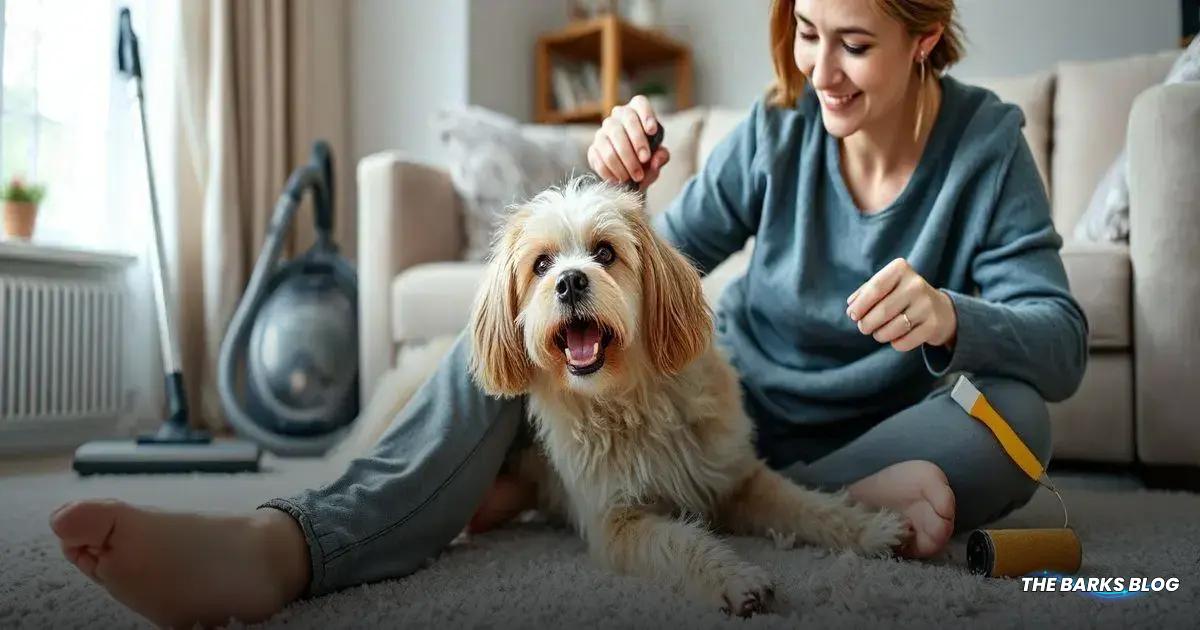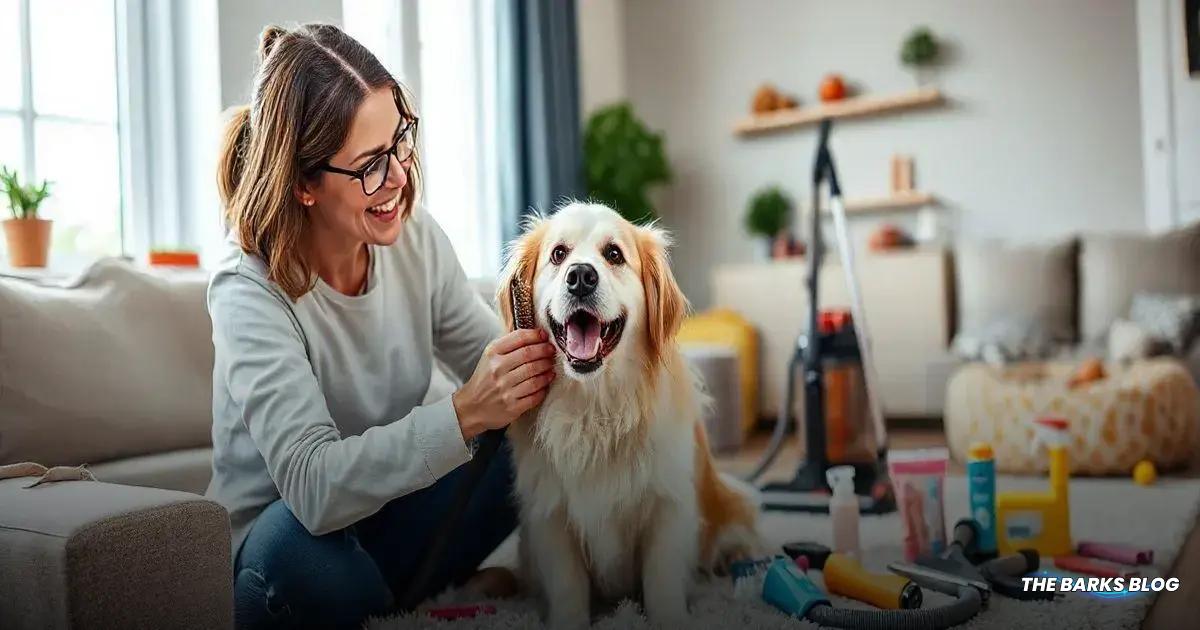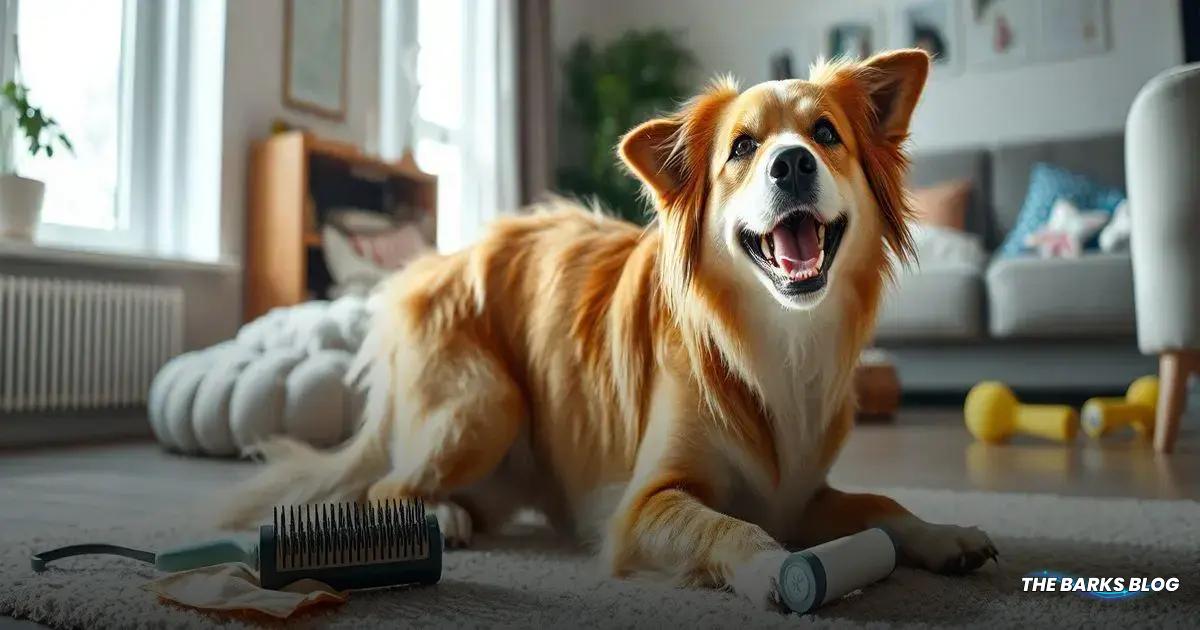Managing dog shedding requires understanding its causes, such as breed and health, and implementing strategies like regular grooming, vacuuming, and using furniture covers. Addressing issues like flea infestations and dietary sensitivities can enhance coat health. A consistent grooming routine and a clean environment will improve comfort for both you and your dog, making pet ownership more enjoyable despite shedding.
As a dog owner, dealing with dog shedding can be a real challenge. While shedding is a natural process, it doesn’t have to take over your life. There are several simple steps you can take to help reduce the amount of fur your pup sheds, making both you and your furry friend more comfortable.

Understanding Why Dogs Shed
Understanding why dogs shed is crucial for any pet owner. Shedding is a natural process where your dog loses damaged or dead hair to make way for new, healthy fur. Almost every dog will experience shedding at some point in their life, but the amount can vary significantly based on several factors.
Here are four of the most common reasons why dogs shed:
Their Breed
Some dog breeds are known for shedding more than others, particularly those with long, shaggy coats or loose dog hair. Breeds like the German Shepherd, Golden Retriever, and Alaskan Husky are notorious for their shedding, especially during the spring and summer months when they lose their winter coats.
Fleas or Sensitivities
If your dog is dealing with a flea infestation, it can irritate their skin, leading to excessive scratching and licking, which in turn causes more hair loss. Additionally, environmental sensitivities can trigger similar reactions. If you suspect your pup is experiencing these issues, consult your veterinarian for advice.
Trauma
Sometimes, shedding can be linked to trauma, particularly in rescue dogs who may have had difficult pasts. Stressful experiences can lead to anxiety, causing your dog to engage in behaviors like licking or nibbling, which can result in patches of hair loss.
Health Issues
Underlying health problems can also contribute to excessive shedding. Issues such as hormonal imbalances, skin infections, or allergies can cause your dog to lose more hair than usual. Regular vet check-ups can help identify and address these health concerns early on.

Effective Grooming Techniques
Effective grooming is one of the best ways to manage dog shedding and keep your home fur-free. Regular grooming not only helps reduce the amount of fur your dog sheds but also keeps their coat healthy and comfortable. Here are some effective grooming techniques to consider:
Regular Brushing
Establishing a regular brushing schedule can significantly reduce shedding. Depending on your dog’s breed and coat type, you may need to brush them daily or a few times a week. Regular brushing helps remove dead hair and prevents matting, which can lead to discomfort for your pup.
Invest in Quality Grooming Tools
Using the right grooming tools can make a world of difference. Invest in a high-quality dog brush designed for your dog’s coat type. For example, slicker brushes are great for long-haired breeds, while bristle brushes work well for short-haired dogs. A de-shedding tool can also help remove loose hair effectively.
Professional Grooming
Consider scheduling regular visits to a professional groomer, especially during peak shedding seasons. Professional groomers have access to specialized tools and techniques that can help manage shedding more effectively than at-home grooming alone.
Bathing Techniques
Bathing your dog can also assist with shedding. Use a gentle dog shampoo that is suitable for your dog’s skin type. Regular baths can help remove loose fur and dander while keeping your dog’s skin healthy. Just be careful not to over-bathe, as this can lead to dry skin, which may worsen shedding.
Hydration and Nutrition
Don’t forget that proper hydration and nutrition play a role in your dog’s coat health. Ensure your pup has access to fresh water and is on a balanced diet that includes essential fatty acids, which can promote healthy skin and reduce shedding.

Managing Sensitivities and Fleas
Managing sensitivities and fleas is crucial in reducing shedding and maintaining your dog’s overall health. Both fleas and environmental sensitivities can lead to excessive scratching and hair loss, making it essential to address these issues promptly.
Here are some effective strategies:
Flea Prevention
Regular flea prevention is key to keeping your dog comfortable and reducing shedding. Consult your veterinarian for the best flea control products suitable for your dog’s age, weight, and health status. Options include topical treatments, oral medications, and flea collars. Make sure to treat your home as well, as fleas can easily infest carpets and furniture.
Regular Check-ups
Routine veterinary check-ups are vital for identifying and managing flea infestations and sensitivities. Your vet can recommend appropriate treatments and preventive measures based on your dog’s specific needs. Don’t hesitate to discuss any concerns you have regarding your dog’s skin or coat health during these visits.
Identifying Environmental Sensitivities
If you suspect your dog has environmental sensitivities, observe their behavior during walks or outdoor activities. Common triggers include pollen, grass, and dust. Keeping a log of when your dog experiences symptoms can help your vet diagnose potential allergies.
Dietary Considerations
Food sensitivities can also contribute to excessive shedding. If you notice your dog shedding more than usual or experiencing skin issues, consider discussing their diet with your vet. They may recommend a hypoallergenic diet or specific food trials to identify potential allergens.
Creating a Comfortable Environment
Ensure your dog has a comfortable living environment. Regularly clean their bedding and living areas to reduce allergens. Consider using air purifiers to minimize dust and pollen in your home, especially during high allergy seasons.
Stress Management
Finally, managing your dog’s stress levels can also help with sensitivities. A calm and relaxed dog is less likely to experience anxiety-related shedding. Create a safe space for your dog at home, and consider using calming aids like anxiety wraps or natural supplements to help them feel more secure.

Tips for Reducing Shedding at Home
Reducing shedding at home can make a significant difference in keeping your living space clean and comfortable. Here are some practical tips to help manage dog shedding effectively:
Regular Vacuuming
One of the most effective ways to keep your home fur-free is to vacuum regularly. If you have a long-haired breed, consider vacuuming two to three times a week to keep up with the shedding. Make sure to clean the vacuum filter frequently to maximize its effectiveness in capturing hair and dander.
Use Furniture Covers
Upholstered furniture tends to attract dog hair, making it essential to protect your couches and chairs. Consider using washable furniture covers designed to trap dog hair. These covers can be easily removed and cleaned, making it simpler to maintain a fur-free home.
Designated Dog Areas
Creating designated areas for your dog can help contain shedding. Train your dog to stay in specific areas of the house, such as a cozy dog bed or a designated room. This practice can help limit the spread of hair throughout your home.
Increase Water Intake
Hydration plays a vital role in maintaining your dog’s skin health. Ensure your dog has access to fresh water at all times. A well-hydrated dog is less likely to experience dry skin, which can lead to excessive shedding.
Grooming Tools at Hand
Keep grooming tools readily available to manage shedding regularly. Have a brush and a lint roller on hand to quickly remove hair from your clothes and furniture. Regularly brushing your dog will also help reduce the amount of hair that ends up on your floors and furniture.
Natural Calming Aids
If stress is contributing to your dog’s shedding, consider using natural calming aids. Products like calming sprays or supplements can help your dog feel more relaxed and reduce anxiety-related shedding. Consult your veterinarian for recommendations on safe and effective options.
Maintain a Clean Environment
Regularly cleaning your home can also help reduce shedding. Dust and vacuum surfaces frequently to eliminate hair and dander. Consider using an air purifier to help filter out allergens and pet hair from the air, creating a healthier environment for both you and your dog.
Conclusion
While shedding is a natural part of being a dog owner, it doesn’t have to overwhelm your life. By understanding the reasons behind shedding and implementing effective grooming techniques, you can significantly reduce the amount of fur in your home.
Managing sensitivities and fleas, along with adopting practical tips for reducing shedding, will create a more comfortable environment for both you and your furry friend.
Remember, regular grooming, proper hydration, and a clean living space are essential components in maintaining your dog’s coat health and minimizing shedding.
With a little effort and attention, you can enjoy all the joys of dog ownership without the constant battle against dog hair!
FAQ – Frequently Asked Questions about Dog Shedding
Why do dogs shed?
Dogs shed to lose damaged or dead hair, making space for new, healthy fur. Factors like breed, season, and health can affect the amount of shedding.
How can I reduce shedding in my home?
Regular grooming, vacuuming, using furniture covers, and maintaining a clean environment can help reduce shedding at home.
What are some effective grooming techniques for my dog?
Establish a regular brushing schedule, invest in quality grooming tools, and consider professional grooming to manage shedding effectively.
How can I manage my dog’s sensitivities and fleas?
Regular flea prevention, routine vet check-ups, and addressing environmental sensitivities can help manage shedding related to these issues.
What dietary changes can help reduce shedding?
Ensuring your dog has a balanced diet with essential fatty acids can promote healthy skin and reduce shedding. Consult your vet for specific recommendations.
How often should I bathe my dog to help with shedding?
Bathing your dog regularly can help remove loose fur, but avoid over-bathing as it can lead to dry skin. Consult your vet for the best bathing schedule for your dog.




